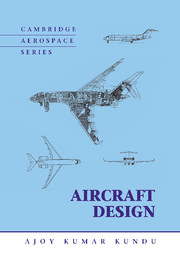Book contents
- Frontmatter
- Contents
- List of Symbols and Abbreviations
- Preface
- Road Map of the Book
- 1 Introduction
- 2 Methodology to Aircraft Design, Market Survey, and Airworthiness
- 3 Aerodynamic Considerations
- 4 Aircraft Classification, Statistics, and Choices for Configuration
- 5 Aircraft Load
- 6 Configuring Aircraft
- 7 Undercarriage
- 8 Aircraft Weight and Center of Gravity Estimation
- 9 Aircraft Drag
- 10 Aircraft Power Plant and Integration
- 11 Aircraft Sizing, Engine Matching, and Variant Derivative
- 12 Stability Considerations Affecting Aircraft Configuration
- 13 Aircraft Performance
- 14 Computational Fluid Dynamics
- 15 Miscellaneous Design Considerations
- 16 Aircraft Cost Considerations
- 17 Aircraft Manufacturing Considerations
- Appendix A Conversion
- Appendix B International Standard Atmosphere
- Appendix C Aerofoils
- Appendix D Case Studies
- Appendix E Tire Data
- References
- Index
12 - Stability Considerations Affecting Aircraft Configuration
Published online by Cambridge University Press: 05 June 2012
- Frontmatter
- Contents
- List of Symbols and Abbreviations
- Preface
- Road Map of the Book
- 1 Introduction
- 2 Methodology to Aircraft Design, Market Survey, and Airworthiness
- 3 Aerodynamic Considerations
- 4 Aircraft Classification, Statistics, and Choices for Configuration
- 5 Aircraft Load
- 6 Configuring Aircraft
- 7 Undercarriage
- 8 Aircraft Weight and Center of Gravity Estimation
- 9 Aircraft Drag
- 10 Aircraft Power Plant and Integration
- 11 Aircraft Sizing, Engine Matching, and Variant Derivative
- 12 Stability Considerations Affecting Aircraft Configuration
- 13 Aircraft Performance
- 14 Computational Fluid Dynamics
- 15 Miscellaneous Design Considerations
- 16 Aircraft Cost Considerations
- 17 Aircraft Manufacturing Considerations
- Appendix A Conversion
- Appendix B International Standard Atmosphere
- Appendix C Aerofoils
- Appendix D Case Studies
- Appendix E Tire Data
- References
- Index
Summary
Overview
Chapter 11 completed the aircraft configuration in the conceptual study phase of an aircraft project by finalizing the external dimensions through the formal-sizing and engine-matching procedures. The design now awaits substantiation of aircraft performance to ensure that the requirements are met (see Chapter 13). Substantiation of aircraft performance alone is not sufficient if the aircraft-stability characteristics do not provide satisfactory handling qualities and safety, which are flying qualities that have been codified by NASA. Many good designs required considerable tailoring of the control surfaces, which sometimes affected changes to and/or repositioning of the wing and incorporated additional surfaces (e.g., dorsal fin and ventral fins).
Preliminary stability analyses, using semi-empirical methods (e.g., DATCOM and RAE data sheets [now ESDU]), are conducted during the conceptual study as soon as the three-view aircraft configuration is available. The analyses include the CG location (see Chapter 8) and preliminary stability results from geometric parameters (e.g., surface areas, wing dihedral, sweep, and twist), which are determined from past experience and statistics. Aircraft dynamic-stability analysis requires accurate stability derivatives obtained from extensive wind-tunnel and flight testing. These are cost-intensive exercises and require more budget appropriation after the project go-ahead is obtained in the next phase (i.e., Project Definition, Phase 2). Manufacturing philosophy is firmed up during Phase 2 after aircraft geometry is finalized, when the jig and tool designs can begin. Phase 2 activities are beyond the scope of this book.
- Type
- Chapter
- Information
- Aircraft Design , pp. 387 - 416Publisher: Cambridge University PressPrint publication year: 2010



